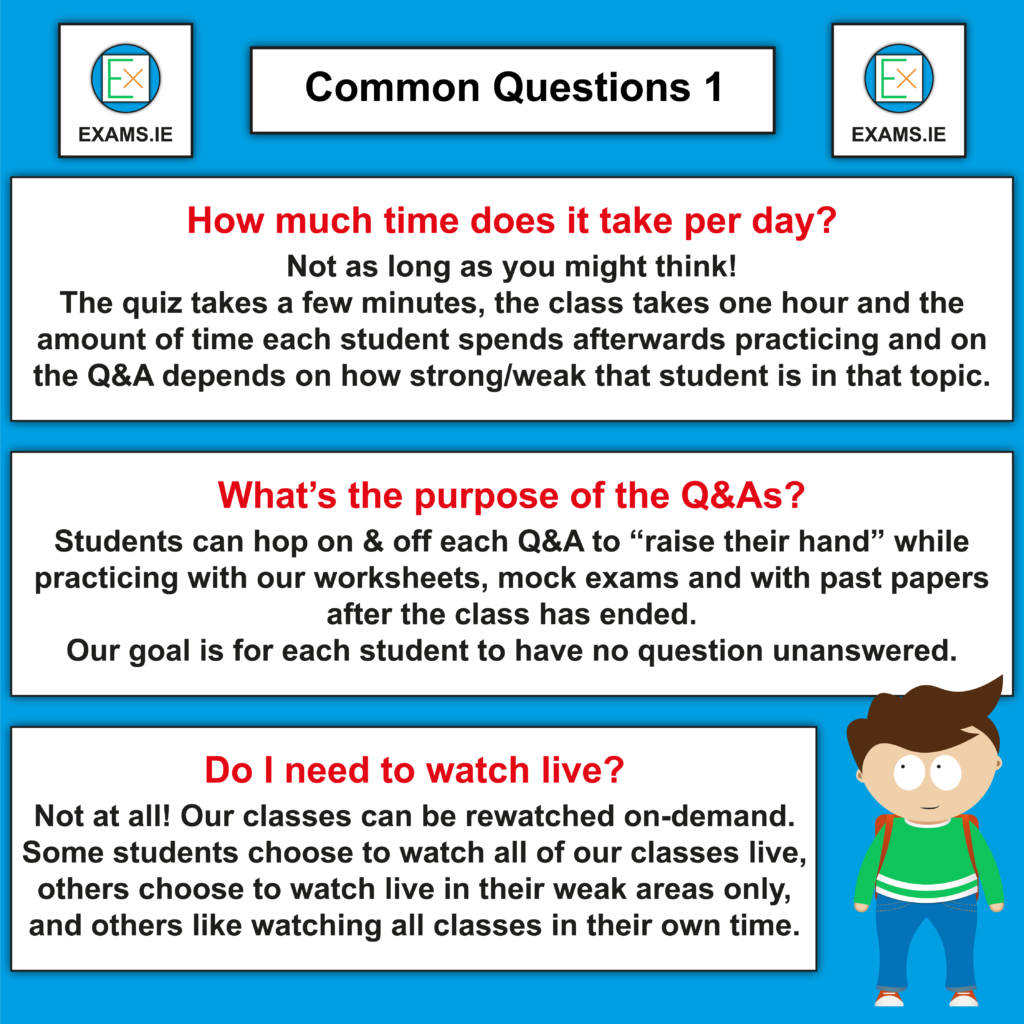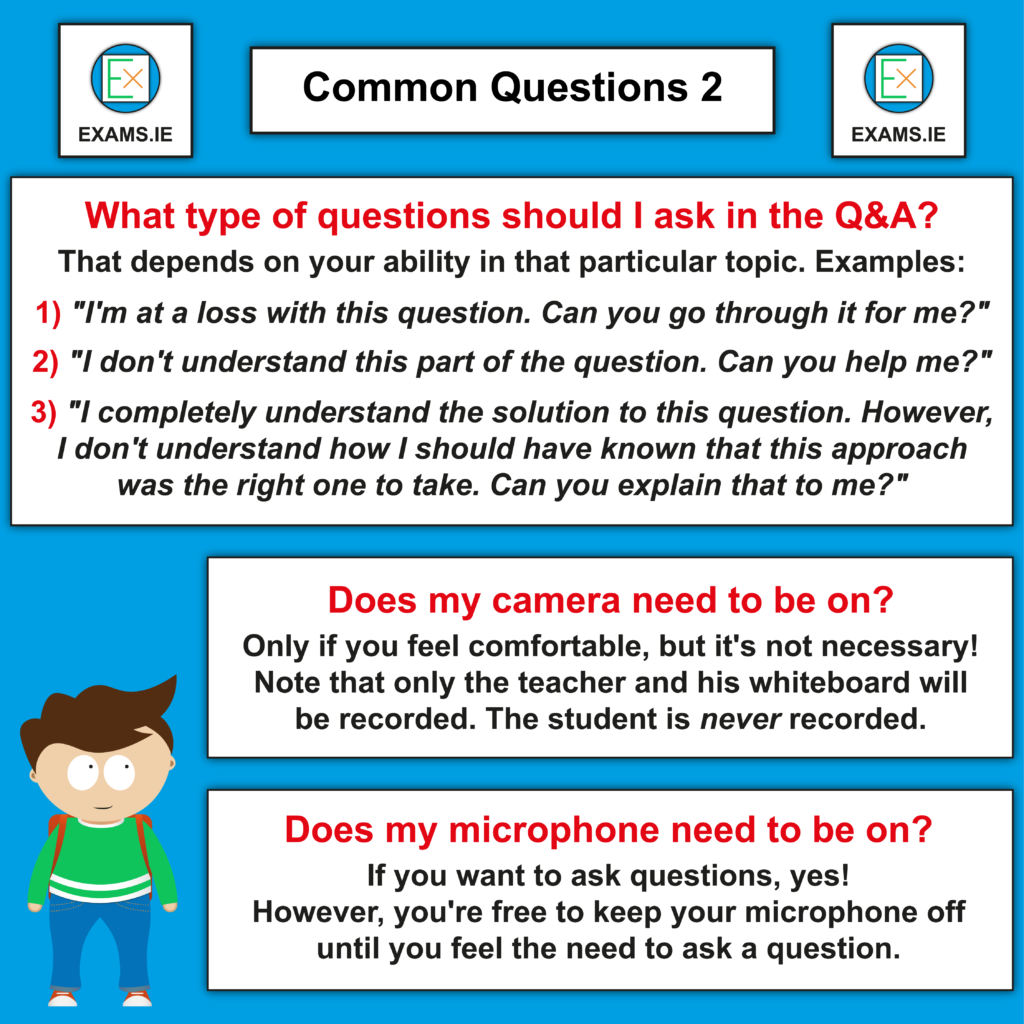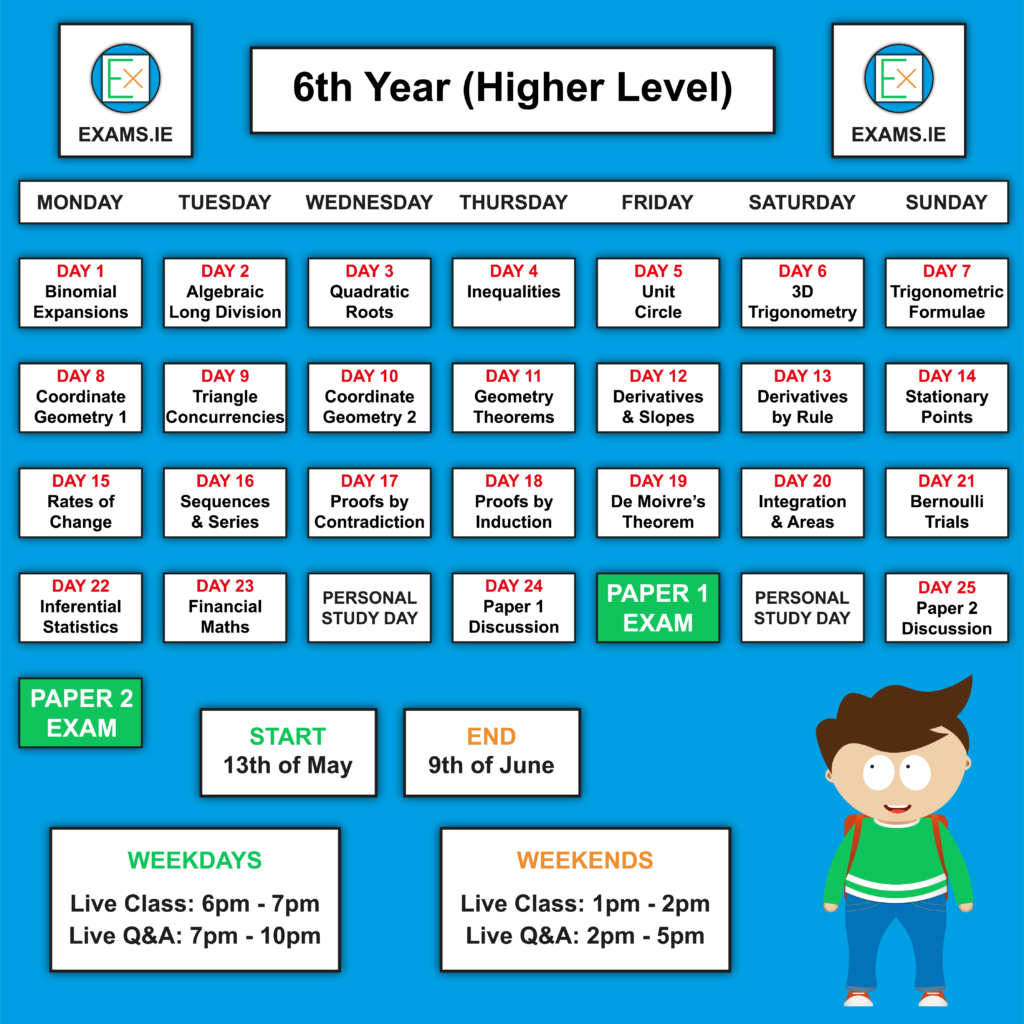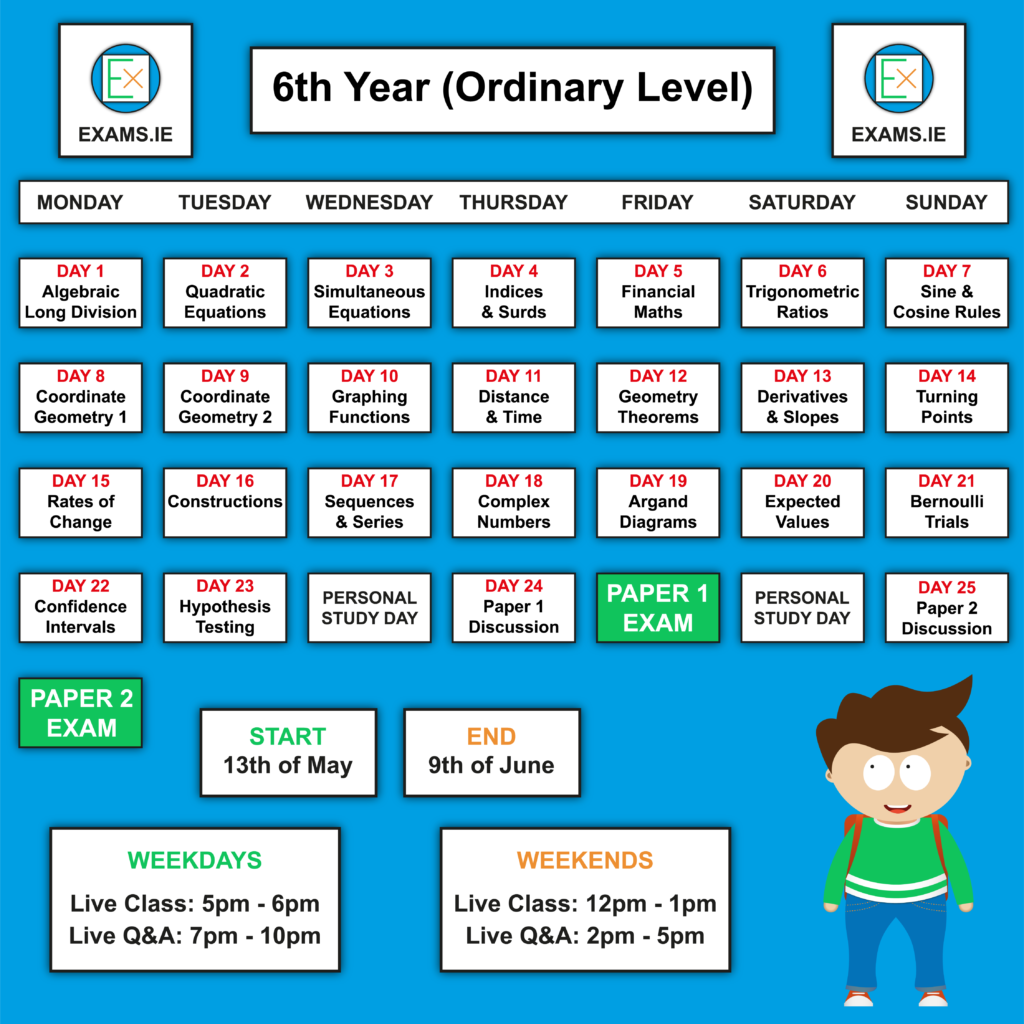MOCK EXAMS
This content is available to students who sign up to our
25 day final revision course.
HL Mock Exam B
Paper 2
Section A
Question 2
(a) The equation of a circle is \(x^2+y^2=16\).
Find the equations of the two tangents to that circle that are parallel to the line \(2x+6y-5=0\).
Answer
\(2x+6y+4\sqrt{40}=0\) and \(2x+6y-4\sqrt{40}=0\)
Solution
The radius of the circle is \(4\) and the equations of the tangents are \(2x+6y+k=0\).
\begin{align}\downarrow\end{align}
\begin{align}r=\frac{|ax_1+by_1+c|}{\sqrt{a^2+b^2}}\end{align}
\begin{align}\downarrow\end{align}
\begin{align}4=\frac{|2(0)+6(0)+k}{\sqrt{2^2+6^2}}\end{align}
\begin{align}\downarrow\end{align}
\begin{align}4=\frac{|k|}{\sqrt{40}}\end{align}
\begin{align}\downarrow\end{align}
\begin{align}|k|=4\sqrt{40}\end{align}
Therefore, the equations of the tangents are \(2x+6y+4\sqrt{40}=0\) and \(2x+6y-4\sqrt{40}=0\).
Video Walkthrough
Members Only!
This content is exclusively for members.
To obtain a membership, or to find out more information about our memberships, click the button below!
(b) Find the equation of the circle below.
Answer
\(x^2+y^2-4x-8y+15=0\)
Solution
\begin{align}x^2+y^2+2gx+2fy+c=0\end{align}
\begin{align}\downarrow\end{align}
\begin{align}1^2+2^2+2g(1)+2f(2)+c=0\end{align}
\begin{align}\downarrow\end{align}
\begin{align}1+4+2g+4f+c=0\end{align}
\begin{align}\downarrow\end{align}
\begin{align}2g+4f+c=-5\end{align}
and
\begin{align}3^2+6^2+2g(3)+2f(6)+c=0\end{align}
\begin{align}\downarrow\end{align}
\begin{align}9+36+6g+12f+c=0\end{align}
\begin{align}\downarrow\end{align}
\begin{align}6g+12f+c=-45\end{align}
and
\begin{align}4^2+5^2+2g(4)+2f(5)+c=0\end{align}
\begin{align}\downarrow\end{align}
\begin{align}16+25+8g+10f+c=0\end{align}
\begin{align}\downarrow\end{align}
\begin{align}8g+10f+c=-41\end{align}
\begin{align}\downarrow\end{align}
\begin{align}2g+4f+c=-5\end{align}
\begin{align}6g+12f+c=-45\end{align}
\begin{align}8g+10f+c=-41\end{align}
\begin{align}\downarrow\end{align}
\begin{align}c=-5-2g-4f\end{align}
\begin{align}6g+12f+c=-45\end{align}
\begin{align}8g+10f+c=-41\end{align}
\begin{align}\downarrow\end{align}
\begin{align}6g+12f+(-5-2g-4f)=-45\end{align}
\begin{align}8g+10f+(-5-2g-4f)=-41\end{align}
\begin{align}\downarrow\end{align}
\begin{align}4g+8f=-40\end{align}
\begin{align}6g+6f=-36\end{align}
\begin{align}\downarrow\end{align}
\begin{align}g+2f=-10\end{align}
\begin{align}g+f=-6\end{align}
\begin{align}\downarrow\end{align}
\begin{align}f=-4\end{align}
and
\begin{align}g&=-6-f\\&=-6-(-4)\\&=-2\end{align}
and
\begin{align}c=-5-2g-4f\\&=-5-2(-2)-4(-4)\\&=15\end{align}
\begin{align}\downarrow\end{align}
\begin{align}x^2+y^2+2(-2)x+2(-4)y+15=0\end{align}
\begin{align}\downarrow\end{align}
\begin{align}x^2+y^2-4x-8y+15=0\end{align}
Video Walkthrough
Members Only!
This content is exclusively for members.
To obtain a membership, or to find out more information about our memberships, click the button below!
Question 3
(a) Solve the following equation:
\begin{align}\tan A =-\sqrt{3}\end{align}
where \(0\mbox{ rad}\leq A\leq 4\pi\mbox{ rad}\) and \(A\) is measured in radians.
Answer
\(A=\dfrac{2\pi}{3}\mbox{ rad}\), \(A=\dfrac{5\pi}{3}\mbox{ rad}\), \(A=\dfrac{8\pi}{3}\mbox{ rad}\) and \(A=\dfrac{11\pi}{3}\mbox{ rad}\)
Solution
\begin{align}R=\frac{\pi}{3}\mbox{ rad}\end{align}
Case 1: Second Quadrant
\begin{align}A&=\pi-\frac{\pi}{3}\\&=\frac{2\pi}{3}\mbox{ rad}\end{align}
Solutions
\begin{align}A=\frac{2\pi}{3}\mbox{ rad}\end{align}
and
\begin{align}A=\frac{8\pi}{3}\mbox{ rad}\end{align}
Case 2: Fourth Quadrant
\begin{align}A&=2\pi-\frac{\pi}{3}\\&=\frac{5\pi}{3}\mbox{ rad}\end{align}
Solutions
\begin{align}A=\frac{5\pi}{3}\mbox{ rad}\end{align}
and
\begin{align}A=\frac{11\pi}{3}\mbox{ rad}\end{align}
Video Walkthrough
Members Only!
This content is exclusively for members.
To obtain a membership, or to find out more information about our memberships, click the button below!
(b) Consider the cube of side length \(6\mbox{ cm}\) below.
Find the angle \(|\angle AHE|\), correct to two decimal places.
Answer
\(35.26^{\circ}\)
Solution
\begin{align}|HE|&=\sqrt{6^2+6^2}\\&=\sqrt{72}\end{align}
\begin{align}\downarrow\end{align}
\begin{align}\tan|\angle AHE|&=\frac{6}{\sqrt{72}}\end{align}
\begin{align}\downarrow\end{align}
\begin{align}|\angle AHE|&=\tan^{-1}\left(\frac{6}{\sqrt{72}}\right)\\&\approx35.26^{\circ}\end{align}
Video Walkthrough
Members Only!
This content is exclusively for members.
To obtain a membership, or to find out more information about our memberships, click the button below!
Question 4
(a) For Peter, the probability that he manages to falls asleep tonight before 10 p.m. is \(0.4\).
If he does fall asleep tonight before 10 p.m., the probability that he will fall asleep before 10 p.m tomorrow night is \(0.7\).
If he does not fall asleep tonight before 10 p.m., the probability that he will fall asleep before 10 p.m tomorrow night is \(0.2\).
(i) What is the probability that he falls asleep before 10 p.m. on both nights?
(ii) What is the probability that he falls asleep after 10 p.m. on both nights?
Answer
(i) \(0.28\)
(ii) \(0.48\)
Solution
(i)
\begin{align}0.4\times0.7=0.28\end{align}
(ii)
\begin{align}(1-0.4)\times(1-0.2)=0.48\end{align}
Video Walkthrough
Members Only!
This content is exclusively for members.
To obtain a membership, or to find out more information about our memberships, click the button below!
(b) Consider the Venn diagram shown below.
Show that \(A\) and \(B\) are independent events.
Answer
The answer is already in the question!
Solution
(a)
\begin{align}P(A)&=\frac{5+2}{5+2+10+25}\\&=\frac{7}{42}\end{align}
and
\begin{align}P(B)&=\frac{10+2}{5+2+10+25}\\&=\frac{12}{42}\end{align}
\begin{align}\downarrow\end{align}
\begin{align}P(A)\times P(B)&=\frac{7}{42}\times\frac{12}{42}\\&=\frac{84}{1764}\\&=\frac{1}{21}\end{align}
and
\begin{align}P(A\cap B)&=\frac{2}{5+2+10+25}\\&=\frac{2}{42}\\&=\frac{1}{21}\end{align}
\begin{align}\downarrow\end{align}
\begin{align}P(A)\times P(B)=P(A\cap B)\end{align}
as required.
Video Walkthrough
Members Only!
This content is exclusively for members.
To obtain a membership, or to find out more information about our memberships, click the button below!
Question 5
The amount of time Chloe spends looking at her phone each day is normally distributed with a mean time of \(200\) minutes and a standard deviation of \(20\) minutes.
On any particular day, what is the probability that:
(a) Chloe spends less than \(200\) minutes on her phone?
Answer
\(0.5\)
Solution
\(0.5\).
Video Walkthrough
Members Only!
This content is exclusively for members.
To obtain a membership, or to find out more information about our memberships, click the button below!
(b) Chloe spends between three and four hours on her phone?
Answer
\(0.8185\)
Solution
(b)
\begin{align}z_1&=\frac{x_1-\mu}{\sigma}\\&=\frac{180-200}{20}\\&=-1\end{align}
and
\begin{align}z_2&=\frac{x_2-\mu}{\sigma}\\&=\frac{240-200}{20}\\&=2\end{align}
\begin{align}\downarrow\end{align}
\begin{align}P(240\leq X\leq360)&=P(-1\leq Z\leq2)\\&=P(Z\leq2)-P(Z\leq-1)\\&=P(Z\leq2)-(1-P(Z\leq1)\\&=\\&=0.9772-(1-0.8413 )\\&=0.8185\end{align}
Video Walkthrough
Members Only!
This content is exclusively for members.
To obtain a membership, or to find out more information about our memberships, click the button below!
(c) Chloe spends more than three hours on her phone?
Answer
\(0.8413\)
Solution
\begin{align}z&=\frac{x-\mu}{\sigma}\\&=\frac{180-200}{20}\\&=-1\end{align}
\begin{align}\downarrow\end{align}
\begin{align}P(X\geq180)&=P(Z\geq-1)\\&=1-P(Z\leq-1)\\&=1-(1-P(Z\leq1))\\&=1-(1-0.8413)\\&=0.8413\end{align}
Video Walkthrough
Members Only!
This content is exclusively for members.
To obtain a membership, or to find out more information about our memberships, click the button below!
Question 6
(a) If the radius of the below circle is \(17\mbox{ cm}\), and if \(|AB|=30\mbox{ cm}\), find \(|DE|\).
Answer
\(9\mbox{ cm}\)
Solution
\begin{align}|OD|&=\sqrt{17^2-\left(\frac{30}{2}\right)^2}\\&=8\mbox {cm}\end{align}
\begin{align}\downarrow\end{align}
\begin{align}|DE|&=|OE|-|DE|\\&=17-8\\&=9\mbox{ cm}\end{align}
Video Walkthrough
Members Only!
This content is exclusively for members.
To obtain a membership, or to find out more information about our memberships, click the button below!
(b) Construct the centroid \(X\) of the below triangle. Show your labels and construction lines clearly.
Answer
Solution
Video Walkthrough
Section B
Question 7
A school is composed of \(200\) Leaving Cert students.
(a) Each of these students were asked whether they are vegan.
\(60\) of the students stated that they are indeed vegan.
Construct a \(95\%\) confidence interval for the population using:
(i) the margin of error.
(ii) a more accurate error approximation than the one used in part (i).
Answer
(i) \(0.23\leq p\leq0.37\)
(ii) \(0.24\leq p\leq0.36\)
Solution
(i)
\begin{align}\hat{p}-E\leq p\leq\hat{p}+E \end{align}
\begin{align}\downarrow\end{align}
\begin{align}\hat{p}-\frac{1}{\sqrt{n}}\leq p\leq\hat{p}+\frac{1}{\sqrt{n}}\end{align}
\begin{align}\downarrow\end{align}
\begin{align}\frac{60}{200}-\frac{1}{\sqrt{200}}\leq p\leq\frac{60}{200}+\frac{1}{\sqrt{200}}\end{align}
\begin{align}\downarrow\end{align}
\begin{align}0.23\leq p\leq0.37\end{align}
(ii)
\begin{align}\hat{p}-E\leq p\leq\hat{p}+E \end{align}
\begin{align}\downarrow\end{align}
\begin{align}\hat{p}-1.96\sqrt{\frac{p(1-p)}{n}}\leq p\leq\hat{p}+1.96\sqrt{\frac{p(1-p)}{n}}\end{align}
\begin{align}\downarrow\end{align}
\begin{align}\frac{60}{200}-1.96\sqrt{\frac{\frac{60}{200}\left(1-\frac{60}{200}\right)}{200}}\leq p\leq\frac{60}{200}+1.96\sqrt{\frac{\frac{60}{200}\left(1-\frac{60}{200}\right)}{200}}\end{align}
\begin{align}\downarrow\end{align}
\begin{align}0.24\leq p\leq0.36\end{align}
Video Walkthrough
Members Only!
This content is exclusively for members.
To obtain a membership, or to find out more information about our memberships, click the button below!
In a particular Higher Level maths class, the mean percentage mark for the most recent midterm exam was \(82\%\) with a standard deviation of \(3.5\%\).
(b) If a student is randomly chosen from that class, what is the probability that that student:
(i) obtained a mark less than \(80\%\)?
(ii) obtained a mark less than \(75\%\)?
Answer
(i) \(0.2843\)
(ii) \(0.0228\)
Solution
(i)
\begin{align}z&=\frac{x-\mu}{\sigma}\\&=\frac{80-82}{3.5}\\&\approx-0.57\end{align}
\begin{align}\downarrow\end{align}
\begin{align}P(X\leq80)&=P(Z\leq-0.57)\\&=1-P(Z\leq0.57)\\&=1-0.7157\\&=0.2843\end{align}
(ii)
\begin{align}z&=\frac{x-\mu}{\sigma}\\&=\frac{75-82}{3.5}\\&=-2\end{align}
\begin{align}\downarrow\end{align}
\begin{align}P(X\leq80)&=P(Z\leq-2)\\&=1-P(Z\leq2)\\&=1-0.9772\\&=0.0228\end{align}
Video Walkthrough
Members Only!
This content is exclusively for members.
To obtain a membership, or to find out more information about our memberships, click the button below!
The heights of Leaving Cert students nationally are found to be normally distributed with a mean of \(172\mbox{ cm}\) and a standard deviation of \(4\mbox{ cm}\).
(c) The heights of this maths class of \(30\) students is measured and recorded.
Find the probability that the mean height of this maths class is:
(i) larger than the mean of the population.
(ii) less than \(170\mbox{ cm}\).
Answer
(i) \(0.5\)
(ii) \(0.0031\)
Solution
(i) \(0.5\)
(ii)
\begin{align}z&=\frac{\bar{x}-\mu}{\dfrac{\sigma}{\sqrt{n}}}\\&=\frac{170-172}{\dfrac{4}{\sqrt{30}}}\\&\approx-2.74\end{align}
\begin{align}\downarrow\end{align}
\begin{align}P(X\leq170)&=P(Z\leq-2.74)\\&=1-P(Z\leq2.74)\\&=1-0.9969\\&=0.0031\end{align}
Video Walkthrough
Members Only!
This content is exclusively for members.
To obtain a membership, or to find out more information about our memberships, click the button below!
A recent study claimed that Leaving Cert students spend, on average, \(5\) hours per week commuting to and from school.
A group of \(80\) Leaving Cert students from this school were asked how many hours they spend commuting per week.
The mean and standard deviation of the resulting normal distribution for this sample was found to be \(4.2\) hours and \(1.5\) hours respectively.
(d) By performing a hypothesis test, determine if there is a \(5\%\) level of significance that the claim is accurate or not.
Answer
Leaving Cert students do not spend, on average, \(5\) hours per week commuting to a \(5\%\) level of significance.
Solution
\(H_0\): Leaving Cert students do not spend, on average, \(5\) hours per week commuting.
\(H_1\): Leaving Cert students do spend, on average, \(5\) hours per week commuting.
\begin{align}\bar{x}-E\leq \mu\leq\bar{x}+E\end{align}
\begin{align}\downarrow\end{align}
\begin{align}\bar{x}-1.96\frac{\sigma}{\sqrt{n}}\leq \mu\leq\bar{x}+1.96\frac{\sigma}{\sqrt{n}}\end{align}
\begin{align}\downarrow\end{align}
\begin{align}4.2-1.96\frac{1.5}{\sqrt{80}}\leq\mu\leq4.2+1.96\frac{1.5}{\sqrt{80}}\end{align}
\begin{align}\downarrow\end{align}
\begin{align}3.87\mbox{ hours}\leq\mu\leq4.53\mbox{ euro}\end{align}
As \(5\) hours is outside of this interval, we accept the null hypothesis that Leaving Cert students do not spend, on average, \(5\) hours per week commuting to a \(5\%\) level of significance.
Video Walkthrough
Members Only!
This content is exclusively for members.
To obtain a membership, or to find out more information about our memberships, click the button below!
Question 8
A tennis ball is dropped from a height \(H\) of \(10\) metres.
The ball’s maximum height after each bounce is half of its maximum height the previous bounce.
(a) Find the ball’s maximum height after two bounces.
Answer
\(2.5\mbox{ m}\)
Solution
\begin{align}h_2&=10\times\frac{1}{2}\times\frac{1}{2}\\&=2.5\mbox{ m}\end{align}
Video Walkthrough
Members Only!
This content is exclusively for members.
To obtain a membership, or to find out more information about our memberships, click the button below!
(b) Show that the ball’s maximum height \(h\) after \(n\) bounces is given by:
\begin{align}h_n=10\left(\frac{1}{2}\right)^n\mbox{ metres}\end{align}
Answer
The answer is already in the question!
Solution
\begin{align}a=5&&r=\frac{1}{2}\end{align}
\begin{align}\downarrow\end{align}
\begin{align}h_n&=ar^{n-1}\\&=5\left(\frac{1}{2}\right)^{n-1}\\&=10\left(\frac{1}{2}\right)^n\end{align}
as required.
Video Walkthrough
Members Only!
This content is exclusively for members.
To obtain a membership, or to find out more information about our memberships, click the button below!
(c) Show that the total distance \(d_n\) travelled by the ball after \(n\) bounces is \(30-0.5^n\) metres.
Answer
The answer is already in the question!
Solution
\begin{align}d_n&=10+2\left(5+2.5+1.25+…\right)\\&=10+2\left(\frac{5(1-0.5^n)}{1-0.5}\right)\\&=10+20(1-0.5^n)\\&=30-0.5^n\end{align}
as required.
Video Walkthrough
Members Only!
This content is exclusively for members.
To obtain a membership, or to find out more information about our memberships, click the button below!
(d) The ball eventually comes to rest. Find the total distance \(D\) travelled by the ball.
Answer
\(30\mbox{ metres}\)
Solution
\begin{align}D&=\lim_{n\rightarrow\infty}d_n\\&=\lim_{n\rightarrow\infty}30-0.5^n\\&=30\mbox{ metres}\end{align}
Video Walkthrough
Members Only!
This content is exclusively for members.
To obtain a membership, or to find out more information about our memberships, click the button below!
(e) A basketball is instead dropped from a different height \(H\).
Its maximum height after each bounce is \(k\) times the maximum height of the previous bounce.
It travels a total distance \(D\) before coming to rest.
Show that:
\begin{align}k=\frac{D-H}{D+H}\end{align}
Answer
The answer is already in the question!
Solution
\begin{align}D&=H+2(kH+k^2H+k^3H+…)\\&=H+2\left(\frac{kH}{1-k}\right)\end{align}
\begin{align}\downarrow\end{align}
\begin{align}D-H=\frac{2kH}{1-k}\end{align}
\begin{align}\downarrow\end{align}
\begin{align}(1-k)(D-H)=2kH\end{align}
\begin{align}\downarrow\end{align}
\begin{align}D-H-kD+kH=2kH\end{align}
\begin{align}\downarrow\end{align}
\begin{align}kD+2kH-kH=D-H\end{align}
\begin{align}\downarrow\end{align}
\begin{align}kD+kH=D-H\end{align}
\begin{align}\downarrow\end{align}
\begin{align}k(D+H)=D-H\end{align}
\begin{align}\downarrow\end{align}
\begin{align}k=\frac{D-H}{D+H}\end{align}
as required.
Video Walkthrough
Members Only!
This content is exclusively for members.
To obtain a membership, or to find out more information about our memberships, click the button below!
Question 9
The probability of any student in a particular class being left handed is \(0.35\).
(a) If two students are chosen at random from this class, find the probability that:
(i) both are left handed.
(ii) both are dominant in the same hand.
Answer
(a) \(0.1225\)
(b) \(0.545\)
Solution
(i)
\begin{align}P&=0.35\times0.35=0.1225\end{align}
(ii)
\begin{align}P&=0.35\times0.35+(1-0.35)\times(1-0.35)=0.545\end{align}
Video Walkthrough
Members Only!
This content is exclusively for members.
To obtain a membership, or to find out more information about our memberships, click the button below!
Each student in that class is asked if they are left handed.
(b) Find the probability (correct to two significant figures) that:
(i) the third student asked is the first left handed student.
(ii) the tenth student asked is the third left handed student.
(iii) the first six students are all right handed.
Answer
(i) \(0.15\)
(ii) \(0.076\)
(iii) \(0.075\)
Solution
(i)
\begin{align}P&=0.65\times0.65\times0.35\\&\approx0.15\end{align}
(ii)
\begin{align}P&={9\choose2}(0.35^2)(0.65^7)\times0.35\\&\approx0.076\end{align}
(iii)
\begin{align}P&=(0.65)^6\\&\approx0.075\end{align}
Video Walkthrough
Members Only!
This content is exclusively for members.
To obtain a membership, or to find out more information about our memberships, click the button below!
Five students from that class are chosen at random to be part of a quiz team.
(c) For this team, find the probability that:
(i) exactly one student is left handed.
(ii) exactly three students are left handed.
(iii) there are more left handed students than right handed students.
Answer
(i) \(0.31\)
(ii) \(0.18\)
(iii) \(0.24\)
Solution
(i)
\begin{align}P&={5\choose1}(0.35^1)(0.65^4)\\&\approx0.31\end{align}
(ii)
\begin{align}P&={5\choose3}(0.35^3)(0.65^2)\\&\approx0.18\end{align}
(iii)
\begin{align}P&={5\choose3}(0.35^3)(0.65^2)+{5\choose4}(0.35^4)(0.65^1)+{5\choose5}(0.35^5)(0.65^0)\\&\approx0.24\end{align}
Video Walkthrough





